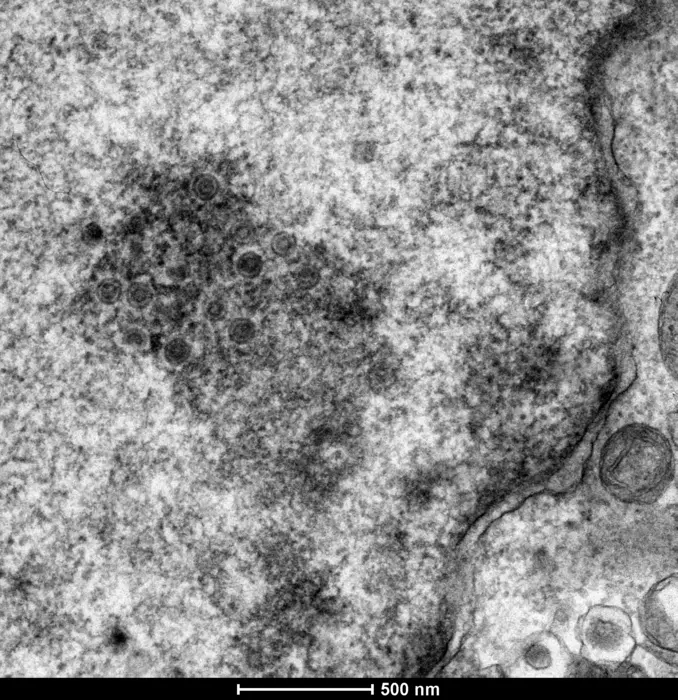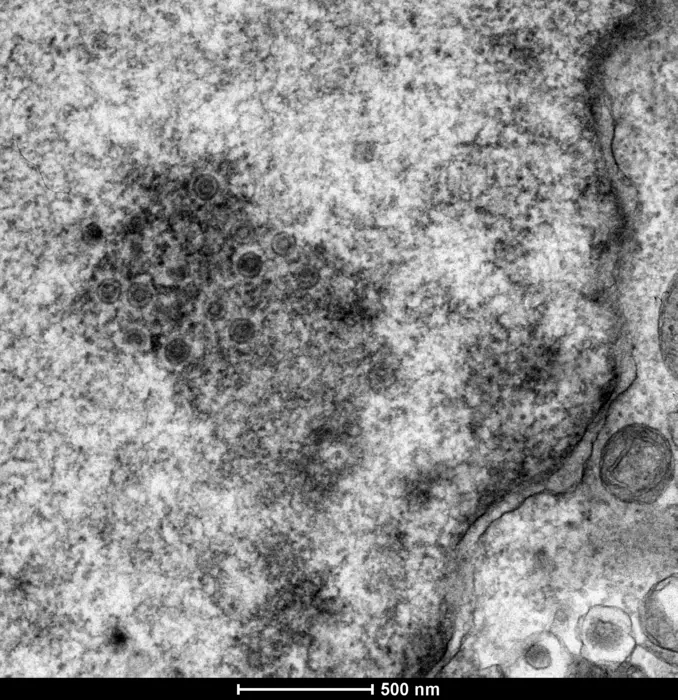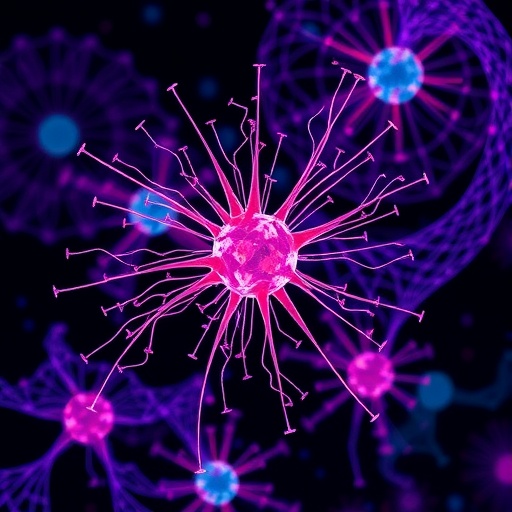An international team of scientists led by geneticists and disease biologists from the University of Oxford and LMU Munich have used ancient DNA to trace the evolution of Marek’s Disease Virus (MDV). This global pathogen causes fatal infections in unvaccinated chickens and costs the poultry industry over $1 billion per year. The findings, published today in the journal Science, show how viruses evolve to become more virulent and could lead to the development of better ways to treat viral infections.

Credit: Credit: The Bioimaging group, Pirbright Institute.
Embargoed until Thursday 14 December 2023, 19:00 GMT / 14:00 ET
Ancient DNA reveals how a chicken virus evolved to become more deadly
An international team of scientists led by geneticists and disease biologists from the University of Oxford and LMU Munich have used ancient DNA to trace the evolution of Marek’s Disease Virus (MDV). This global pathogen causes fatal infections in unvaccinated chickens and costs the poultry industry over $1 billion per year. The findings, published today in the journal Science, show how viruses evolve to become more virulent and could lead to the development of better ways to treat viral infections.
The team, which includes archaeologists and biologists, recovered and reconstructed ancient MDV sequences from archaeological chickens spanning the past 1,000 years. By comparing viral genomes derived from both modern and ancient birds, they were able to pinpoint the genetic alterations responsible for the increased virulence of the modern virus.
Based on the ancient genetic sequences, they were also able to resurrect ancient biological processes using cellular assays, demonstrating that ancient strains were significantly milder than their modern counterparts.
This breakthrough not only sheds light on the evolutionary history of MDV, but also holds promise for the development of more effective therapies against this devastating poultry disease.
This new study is based on DNA isolated from chicken bones that were excavated from 140 archaeological sites in Europe and the Near East. These ancient genomes revealed that MDV was widespread in European chickens at least 1,000 years before the disease was first described in 1907. This highlights the importance of preserving archaeological remains, especially given their power to reveal valuable insights into the evolution of virulence.
When first described, this disease only led to mild symptoms in older chickens. As chicken consumption dramatically increased in the 1950s and 1960s, MDV has continued to evolve and has become increasingly aggressive despite the development of several vaccines.
First author Dr Steven Fiddaman (Department of Biology, University of Oxford) said: “Our findings not only unravel the evolutionary history of the Marek’s Disease Virus but also provide a foundation for enhancing our current understanding of pathogen virulence. By combining ancient DNA techniques with modern genomics, we’ve opened a window into the past that can guide future strategies in managing viral diseases.”
Professor Naomi Sykes (University of Exeter), lead archaeologist on the study, stated: “This study underscores the profound significance of biological material preserved in archaeological and museum collections since we cannot foresee how their investigation might possess transformative applications in the future.”
Professor Laurent Frantz (LMU Munich), co-senior author of the study stated: “Our work highlights the power of interdisciplinary collaboration, bringing together paleogeneticists, virologists, archaeologists, and biologists to unravel the complex evolutionary history of a pathogen with significant economic and agricultural implications.”
Professor Greger Larson (University of Oxford), co-senior author commented: “We have seen how mitigating diseases often creates a selection pressure that increases the virulence of the virus. Being able to watch this process take place by sequencing ancient virus genomes shows just how dramatically the virulence of MDV has increased in the past century.”
Professor Adrian Smith (Department of Biology, University of Oxford), co-senior author said: “Ancient DNA has provided us with a unique perspective on the emergence of MDV as a deadly chicken virus and may teach us lessons that are applicable to the control of other viral infections of medical and veterinary importance.”
Professor Venugopal Nair, Scientist Emeritus at The Pirbright Institute, said: “Findings from this paper on the origins of virulence, particularly associated with the genetic sequences of the ancient Marek’s disease viruses, will provide great scientific opportunities to explore the molecular mechanisms of increasing virulence of this virus that coincided with the intensification of poultry farming from the 1960s.”
Notes for editors:
The study Ancient chicken remains reveal the origins of virulence in Marek’s disease virus will be published in Science on Thursday 14 December 2023, 09:00 GMT / 14:00 EST. It will be available online when the embargo lifts at DOI 10.1126/science.adg2238. To view a copy of the paper before the embargo lifts, contact [email protected].
For media interviews and more information, please contact:
Steven Fiddaman, University of Oxford
07792457593
Laurent Frantz, LMU Munich
+4915159106325
Adrian Smith, University of Oxford
+441865271195
07771 997868
Greger Larson, University of Oxford
+447963905362
About the University of Oxford
Oxford University has been placed number 1 in the Times Higher Education World University Rankings for the eighth year running, and number 3 in the QS World Rankings 2024. At the heart of this success are the twin-pillars of our ground-breaking research and innovation and our distinctive educational offer.
Oxford is world-famous for research and teaching excellence and home to some of the most talented people from across the globe. Our work helps the lives of millions, solving real-world problems through a huge network of partnerships and collaborations. The breadth and interdisciplinary nature of our research alongside our personalised approach to teaching sparks imaginative and inventive insights and solutions.
Through its research commercialisation arm, Oxford University Innovation, Oxford is the highest university patent filer in the UK and is ranked first in the UK for university spinouts, having created more than 300 new companies since 1988. Over a third of these companies have been created in the past five years. The university is a catalyst for prosperity in Oxfordshire and the United Kingdom, contributing £15.7 billion to the UK economy in 2018/19, and supports more than 28,000 full time jobs.
The Department of Biology is a University of Oxford department within the Maths, Physical, and Life Sciences Division. It utilises academic strength in a broad range of bioscience disciplines to tackle global challenges such as food security, biodiversity loss, climate change and global pandemics. It also helps to train and equip the biologists of the future through holistic undergraduate and graduate courses. For more information visit www.biology.ox.ac.uk.
About LMU Munich
As one of Europe’s leading research universities, LMU Munich is committed to the highest international standards of excellence in research and teaching. Building on its more than 500-year-tradition of scholarship, LMU covers a broad spectrum of disciplines, ranging from the humanities and cultural studies through law, economics and social studies to medicine and the sciences. 20 percent of LMU‘s 52,000 students come from abroad, originating from 140 countries worldwide. The know-how and creativity of LMU’s academics form the foundation of the University’s outstanding research record. This is also reflected in LMU‘s designation as a “university of excellence” in the context of the nationwide Excellence Strategy to promote top-level university research. www.lmu.de/en
Journal
Science
DOI
10.1126/science.adg2238
Article Title
Ancient chicken remains reveal the origins of virulence in Marek’s disease virus
Article Publication Date
14-Dec-2023





